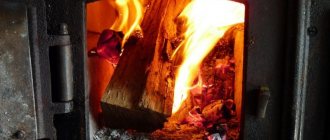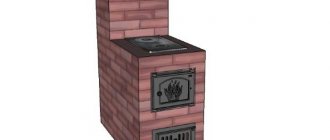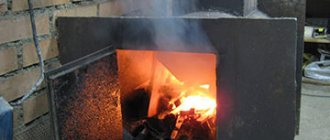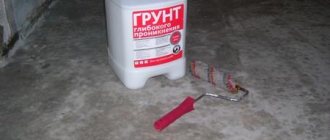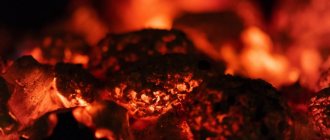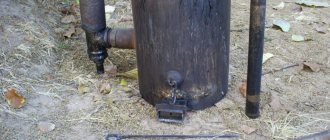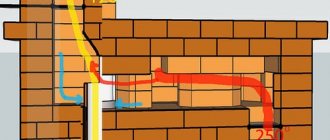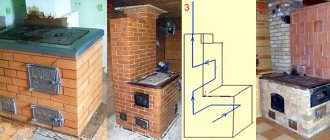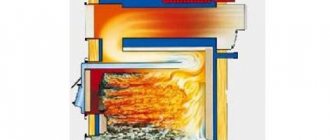Among brick structures, it is the two-bell heating and cooking stove with an oven that remains relevant. The design combines 2 important functions - heating the room and the ability to prepare food due to the presence of an oven and hob. An interesting fact is that a similar two-bell Kuznetsov stove with an oven can be installed with your own hands without excessive effort, but using a simple ordering scheme and taking into account general recommendations.
Device Description
The two-bell heating and cooking system is compact in size and is suitable for heating a room with a total area of up to 45 square meters. This model is characterized by a maximum heat transfer power of 4200 kcal/hour. The combustion chamber is made of special refractory bricks that are resistant to high temperatures. A stove with several burners is mounted inside the firebox. If desired, the structure is decorated with a beautiful arch, making the brick structure a beautiful element of the interior.
At the user's request, an additional drying chamber is often installed.
What else you should know
The combustion chamber is connected to the hood by a vertical slot, which is called a dry seam. The need for such a constructive solution is caused by convection currents moving in both compartments. A portion of the flue gas containing a large amount of steam is drawn into the combustion chamber to be re-cycled, which improves the combustion of volatile particles and causes turbulence.
The blower is filled with air not only through the grate, but also from above, through cavities in the walls. Again, this is required for complete combustion of volatile particles, because the air entering through the grate, when reaching the top of the torch, practically does not contain oxygen.
Above the combustion chamber is a grate of refractory bricks called a catalyst. It heats up to high temperatures and, as it were, burns out everything that remains after incomplete combustion of the fuel.
Types of designs with an oven
Kuznetsov furnace
It is installed in rooms with minimal space possibilities, while the design and decoration are selected individually. A special feature of this type of furnace system is its high efficiency, which for such devices is more than 80% along with a small amount of soot formed during operation. The design is suitable for placement in any area of the room; it is possible to place several similar stoves at once. Any type of solid fuel is suitable for the firebox.
Swedish stove with oven
In construction practice, it is known to use two variants of the stove system: IP1 and IP2, which includes an oven. The design consists of 30 rows, like the Kuznetsov stove. Provides a summer operation mode without heating the room using valves. Taking into account the direct stroke valve system, it is possible to heat the pipe up to 150 degrees in a relatively short period of time. Instead of an arch, which is typical for Kuznetsov’s design with rapid heating, the Swede uses an ordinary brick covering.
Bykov's device
The thick-walled structure has a simple laying pattern and a rectangular shape. This type of stove provides for placing the device in 2 rooms at the same time. Nevertheless, the Bykov design has significant differences in its structure from bell-type structures. The lower region includes 2 gas channels: ascending and descending. The upper part has the shape of a sieve, the cap of which is divided by 5 channels.
Step-by-step instructions for building a Swede with a fireplace
A Swedish stove with a fireplace is the most modern option that will beautifully complement the interior of the room. For independent construction you will need an ordering diagram. Let's take a closer look at the step-by-step actions:
- The laying of the first row is continuous.
- On the second row, you need to take care of installing the grille.
- In the third row, an ash pit is formed and a door is mounted. A vertical channel is being formed. Located parallel to the oven opening.
[Photo 5 Arrangement diagram for Swedes with a fireplace.]
- To clean the ash pan, it is necessary to have two doors, after which the firebox is laid out.
- The fourth row will be identical to the previous one.
- The fifth row provides for the formation of an installation location for the grate.
- In the sixth row, the laying of the partition between the oven zone and the vertical flue channel begins. At this stage, the firebox door is also installed.
Advice! The partition is laid using the quarter-brick method.
- From the seventh to the ninth rows, laying is carried out according to the scheme. Two steel strips are laid on the last row.
- In the 10th row, the construction of a place to clean the fireplace from ash begins. A place for the hob is also laid out.
- In the 11th row a cooking niche is formed.
- On the 12th row, bricks cut diagonally towards the grate are laid out in the front wall of the fireplace.
- Rows 13-15 are similar to the previous ones.
[Photo 6 Oven in the process of installation.]
- To complete the installation of the niche for the hob, three metal strips are laid.
- From the 19th row, the formation of the chimney begins. Bricks on both sides are cut and laid between the fireplace and the flue vertical channel.
- The next 3 rows are laid identically, forming a window for the channel cleaning doors. Gradually the partition should shift to the left side.
- The valve for the fireplace is installed when laying the 24th row, for the stove - in the 25th.
- The cleaning door is installed in the 26th row. Here the chimney will be connected to the flue duct.
- On the 29th row, the laying will be continuous, forming a hole for the chimney.
- From the 32nd row the chimney is being laid.
[Photo 7 beginning of the formation of the chimney]
Advice! Before laying, the brick must be wetted. The material must be carefully selected and must be free of defects.
The Swede is a heating device with good efficiency indicators. Its compact dimensions allow you to use the stove as a decoration, heating device and cooking surface, without taking up much space.
Bell-type heating stove with oven
Price on request
Read more
Stove complex with a stove for a cauldron
Price on request
Read more
Mechanism of operation
In the process of laying a furnace, it is important to understand what operating principles the device is guided by. The functionality of the device is ensured by two caps. The hood is a special furnace chamber that has an opening for the exit and entry of the corresponding gas flows. An important design element is that the stove is capable of quickly heating up, heating the room and at the same time maintaining the necessary heat in the house for a long period of time, even when the damper is open. Moreover, all products obtained during the combustion process freely leave the furnace structure on their own.
There are 2 options for the design:
- Summer type. In the hot season, when there is no need for heating the room, the structure is used exclusively for the cooking process. In this case, it is important to use the valve system correctly so that hot air does not enter other parts of the furnace and heat the structure.
- Winter type. During a sudden cold snap, it is necessary to open all valves to ensure the unhindered passage of gas flows in the channel system.
Types of bell furnaces
I.V. Kuznetsov has developed more than one and a half hundred models of furnaces that can be used for a variety of purposes.
Moreover, their configuration and dimensions may vary depending on the location of the caps. Typically, in order to save space occupied by the furnace, the hoods are positioned vertically. On top of each other. But they can be positioned horizontally. In this case, the stove turns out to be low, but long.
Having first encountered Kuznetsov’s stoves on his website, amateur stove makers are confused about the labeling of stoves, not knowing which design to choose for specific purposes.
Kuznetsov’s marking system for his furnaces is not difficult:
- IOK – pure heating stove;
- HOVIC - heating and cooking without the use of fireclay bricks;
- OVIK BK – heating and cooking room with a side fireplace;
- OVIK ZK – heating and cooking room with rear fireplace;
- OVIK L – heating and cooking with a stove bench;
- The letter “D” is added to the marking index if there is an oven;
- PKIK 1 K – ovens with a built-in heater;
- BIC – sauna stoves;
- RTIC - Russian bell-type stoves.
Based on the markings, you can select the required type of oven. The advantage of any Kuznetsov stove project is that for each type there are several sizes with different heat transfer performance. And each project is given in relation to the layout and area of the heated room. Therefore, there is no need to make independent rather complex calculations in order to choose one option or another.
What materials and tools are used?
Construction work will be impossible without the use of appropriate equipment and necessary materials. Before starting construction, you need to make sure that ready-made components are available. For a bell furnace you will need the following material:
- red and fireclay brick;
- waterproofing sheet for the foundation;
- metal corner;
- mortar kit (sand, clay, cement);
- combustion door, cleanout door, ash door;
- grates;
- cooking surface (presumably cast iron);
- oven;
- chimney valves of different sizes;
- reinforcing mesh.
In addition, the work will not be ensured if the following tools are not available:
- trowels of different sizes;
- building level and rule;
- tape measure for measurements;
- pickaxe hammer;
- equipment for sewing seams;
- shovels;
- container for mixing the solution;
- mop and rags.
Solution for two-bell oven
The classic version of the stove structure involves a clay solution. Each specialist knows his own recipe for the ideal mixture for a brick oven with bottom heating. The building mass must necessarily include high-quality clay of sufficient fat content, as well as fine-grained sand, which, together with the clay base, must have the consistency of thick sour cream. After the mixture is ready, a quality check takes place. Balls are rolled out of the mass and baked in the oven. If, after cooling, the item does not crack, the solution is of acceptable standards. When such a ball is thrown from a height, and it does not lose its shape and remains intact, then the mixture can be considered ideal for work.
How to build a structure?
The ordering of the Kuznetsov or Podgorodnikov two-bell furnace is carried out in accordance with the operating diagram. Before taking any measures to arrange the facility, you need to study all the main points that the drawings contain. Half of the mistakes that a brick structure will have in the future are related precisely to the incorrect implementation of the project. After the foundation is ready, the process of laying out the furnace begins. Brick rows are laid in strict order, each subsequent row is measured at the building level for errors in work. The final stage of the work is the construction of the chimney structure. After all the oven elements are ready, you should start the device for the first time. The test run should not be carried out at full power, so it is not recommended to use large amounts of fuel.
